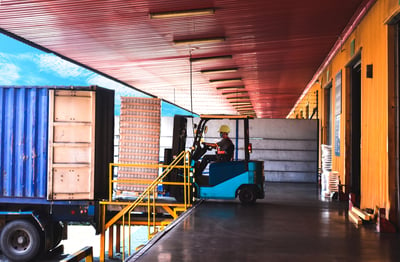Shortage, disruption, shock – three modifiers of today’s supply chain. Only a company with crafty purchasing and secure supply chain management will find a way through with minimal disturbance to their business. Who knows, if done right, they may even end up with new supplier relationships, a modified product portfolio and happier clients.
Procurement and supply chain management walk hand in hand: ego and alter ego, shadow and persona, Daphne and Velma.
On the one hand, procurement includes all those activities that keep you making stuff, such as sourcing, negotiating, purchasing, receiving, and payment. In this game of quickfire acquisition, strategic sourcing is a big key to procurement success. Getting the role of procurement and the flow of goods and services right impacts everything from product quality and break-even price right down to simple, honest availability.
On the other hand, supply chain management focuses on the most efficient and quickest way to get goods to customers while maintaining quality. Like a bold, black cup of Joe from the coffee supply chain, a robust integrated logistics solution will keep everything regular and on rails – with automation, invoicing, auditing, data interpretation, benchmarking, and even compliance and regulations.
It’s an intricate fandango, the duck and dip and fancy twirl that takes place, day in and day out, between purchasing and integrated logistics management. But the goal is always clear: Don’t fall; stay on budget’s relentless beat while gracefully ensuring business processes continue.
Companies must be fleet of foot to support a fast-moving supply chain. The key word here is "moving." The materials and ingredients that go into the products and packaging need to move swiftly down the chain. Product must arrive at point of sale or directly to consumers on time.
Which brings us to a fun little history question. When did the businesslike yet oddly flirtatious handshake between procurement and supply chain management begin? Well, arguably, it all began with the world’s first tourist trap.
The origin of procurement: 6.5 million tons of stone
Here's a fun fact for you. The first trace historians can find of procurement and supply chain management working hand in hand may have been around 3000 BCE, when Egyptians fired up their millennia-long love affair with pyramids, reports Procurement Magazine. Sourcing and materials management helped locate the stone quarried and shaped into blocks at Giza, the limestone used for the casing from Tura, and the granite for the King’s Chamber from quarries up the Nile at Aswan. Logistics management got the stone loaded onto boats, transported down the Nile, unloaded and up into place atop the structure. It may well be history’s first example of on-time delivery.
Building the pyramids was quite a feat. The process involved a workforce of 100,000 men, and one pyramid required over 20 years of hard labor. Luckily, our supply chains are faster and less labor-intensive today, but we do wonder: What would the pyramids look like if they had been managed by Amazon Prime? At the very least there’d be a lot more advertising. There’d probably also be a guy out front saying “If you like this pyramid, you’ll love the one ten miles that way.”
Consumer Packaged Goods: A $2 trillion a year market
Consumer packaged Goods (CPG) manufacturers have had a unique, and in many cases lucrative, relationship with the pandemic consumer. Over the past two years, CPGs have benefitted from changing consumer trends including:
- Stock-piling pantries while hoping finished goods can remain stable for an extended period.
- A shift away from spending on travel, entertainment and eating out toward products used at home
- Influxes of stimulus money that supported extended opportunities for improvement in the broader economy.
These changing patterns will continue to evolve with new COVID variants and ever-changing consumer behavior, as well as in response to the quagmire of other disruptions–-the election, the Olympics of 2024, the resurgence of uncertainty in the global landscape, but one thing is certain – Americans will continue to consume., according to the Consumer Brands Association. The spotlight is now on how to meet demand.
A new approach is the way forward
What is the way forward for CPG companies faced with emergent disruptions that could make the great toilet paper shortage of 2020 seem inconsequential? E.J. Kenney, Senior Vice President Consumer Products Industry Business Unit at SAP, professes to Forbes that this path leads to a new approach to procurement.
It’s time to throw in some stats that’ll make you sit up and take notice without throwing in the towel:
- 49% of CPG executives said that most or all their procurement processes are manual
- 46% reported poor visibility into their inbound shipment status
- 37% said they struggled to understand their suppliers’ ability to meet demand
- Only 23% of respondents say they can effectively collaborate with suppliers
Wow, if there was ever a time when the industry needed the guidance of supply chain consultants and 3PLs to direct and supplement business operations, it is now. Supply chain management is tricky and getting trickier by the quarter. Without visibility, the tools to understand the data – or the automation to connect shipping to accounts and carriers to their pick-ups and deliveries –it can feel a bit like a bargain-basement free-for-all with not enough shopping carts.
Who grabs the carrier capacity and at what price is anybody's guess … if you can arrange the shipment at all.
CPG supply chain challenges

Supply chain acceleration is overwhelming, driven as it is by competition among retailers and retail channels, including online versus brick and mortar. CPGs are fighting to preserve already slim margins by adjusting their product mix to meet new geographic and demographic demands. Managing the global supply chain is fraught with risk associated with delays, rampant counterfeiting and tightening regulations. Supply chain has become a dirty word, one that managers associate with too much cost, not enough time.
On top of that, sourcing materials has become especially challenging today. Everything from finding raw materials, to replacement parts, auxiliary supplies, and operating supplies has become problematic. It's all about getting the right material, at the right price, delivered at the right time. When the purchasing process hits a bump – or worse yet, a complete roadblock – then manufacturing is impacted, resulting in production interruption, stock inventory depletion or excess, or late and unreliable deliveries. The fallout? Lost business, unhappy customers, and a diminishing bottom line.
All these challenges make it easy to see that future proofing business relies on a firm handshake between logistics management and procurement.
Getting procurement and supply chain management on the fast track to success with IL2000
As the world adjusted to the drastic shifts of the past two years, supply chain management consultants have focused on ways to improve profits and productivity through supply chain refinement, including optimizing freight shipments, saving or at least controlling costs, and interpreting data to make more informed and timely decisions.
Based on these learnings, we advise these ways to win in today’s market:
Take a proactive, rather than reactive, approach that begins with analyzing company needs
- Collaborate with suppliers to streamline operations and reduce costs
- Use BI and data to spot savings and minimize risk
- Avoid costly disruptions by keeping the supply chain moving
- Boost the accuracy of your freight audits and payments
This sounds like a lot to manage. And it is. But looking to the future, a strong relationship between all these procurement and supply chain moving parts will be the difference between loss and disruption, or agility, perseverance and profit.
Many companies turn to a 3PL to help mitigate supply chain issues, ensure on-time delivery of a quality product, control costs, reduce person-hours and ensure smooth running.
Ask a subject matter expert if you'd like to see how this could benefit your business.



